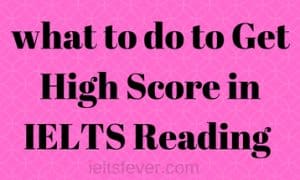what to do to Get High Score in IELTS READING Exam
Dear Students, please follow the following steps to get the score high in the exam
(1) How much studying do I need to do?
Many students like to ask the question, “When can I get a grade 6.0?” or similar problems. It is impossible for your teacher to say unless he knows you very well. Even then the answer given would be more like a guesstimate. People learn at different speeds, and the amount of homework they are prepared to do also varies from person to person. However, an approximate guide suggested by Cambridge ESOL is shown below. Someone requiring an overall grade of 6.0, for example, should expect to study (with a teacher) for between 500 and 600 hours if starting with no knowledge of English. Somebody hoping to improve from a grade 5.0 to grade 6.0 would need about 100 hours of studying.
| Hours of Studying | IELTS grade |
| 1000 – 1200 hours | 7.5+ |
| 700 – 800 hours | 6.5 – 7.0 |
| 500 – 600 hours | 5.0 – 5.5 – 6.0 |
| 350 – 400 hours | 3.5 – 4.0 – 4.5 |
| 180 – 200 hours | 3.0 |
| 90 – 100 hours | 1.0 – 2.0 |
Source: CEF and Cambridge ESOL recommended guidelines
(2) How should I read?
This might seem a rather obvious question, but it is, nevertheless, worth asking before you start to work through this book: “How should I read?” If you think carefully about this, you will probably conclude that it depends on what you are reading and why you are reading it.
Although there are many different types of reading material, it is possible to divide them into two main groups:
1. The things you read for pleasure, like novels
2. The things you read when studying (or fact-finding)
When you read for pleasure, you will tend to focus more on being entertained and will enjoy the actual style of writing used, but when you learn to study you do so to collect facts and figures.
With both types of reading, you can be either a passive reader or an active one. Which one do you think is a better way of reading?
(3) Two Styles of Reading

The main problem with a passive reader is that they want the writer to do all of the work. They want the writer to think, the analyzing, the development of ideas, to state what is important and what isn’t, what the implications of reading this are, how to use the information in the future and so on. The result is that the passive reader often reads slowly, has trouble concentrating, and has no real understanding of the structure of the thing they are reading.

The active reader, on the other hand, develops an ongoing relationship with the writer. Information is read critically and any observations made are related to information previously read, or experience and knowledge obtained. An understanding of the structure of the text (even a form or newspaper) is essential if a more active approach to reading is used. Scanning, skimming and reading for further detail are all active reading skills and would not normally be used when reading for leisure.
Remember, it is your choice. Do you want to be an active or a passive reader? If you are already an active reader then well done. Do not change your style of reading as this is the correct way to read when at the university. This style is also essential when studying for, and when taking, the IELTS test. If you are a passive reader, you MUST change, and this book will help you to do that.
what to do to Get High Score in IELTS Reading Exam what to do to Get High Score in IELTS Reading Exam
 what to do to Get High Score in IELTS Reading Exam what to do to Get High Score in IELTS Reading Exam
what to do to Get High Score in IELTS Reading Exam what to do to Get High Score in IELTS Reading Exam
Also, Read The Active and the Passive voice English Grammar
https://www.facebook.com/ieltsfever
TIP(1) GENERAL READING PARAGRAPH 3 Sample reading text
Pages Content

can you give me the some tips of speaking reading and writing task 2